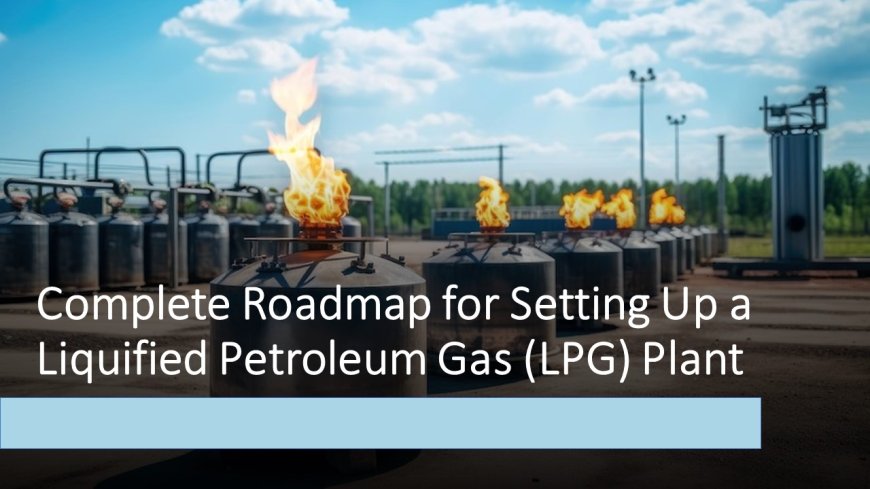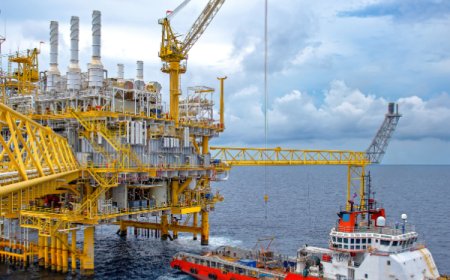Raw Material Requirements for Setting Up a Liquified Petroleum Gas (LPG) Manufacturing Plant
The LPG manufacturing plant report offers insights into the manufacturing process, financials, capital investment, expenses, ROI, and more for informed business decisions.

IMARC Groups report, Liquified Petroleum Gas (LPG) Manufacturing Plant Project Report 2025: Industry Trends, Plant Setup, Machinery, Raw Materials, Investment Opportunities, Cost and Revenue, offers a comprehensive guide for establishing a liquified petroleum gas manufacturing plant. The LPG manufacturing plant report offers insights into the manufacturing process, financials, capital investment, expenses, ROI, and more for informed business decisions.
Liquified Petroleum Gas (LPG)Manufacturing Plant Project Report Summary: -
- Comprehensive guide for setting up a liquified petroleum gas (LPG) manufacturing plant.
- Covers market trends and industry outlook for 2025.
- Detailed project setup, including unit operations and processes.
- Raw material and utility requirements.
- Infrastructure and machinery specifications.
- Workforce and staffing requirements.
- Packaging and transportation details.
- Financial aspects: investment opportunities, cost analysis, and revenue projections.
In addition to covering operational aspects, the report offers detailed insights into the liquified petroleum gas (LPG) manufacturing plant process and project economics.
- Detailed insights into the liquified petroleum gas (LPG) manufacturing plant.
- In-depth project economics and financial metrics.
- Covers capital investments and project funding.
- Analysis of operating expenses and income projections.
- Breakdown of fixed and variable costs, direct and indirect expenses.
- Evaluation of ROI (Return on Investment) and NPV (Net Present Value).
- Profit and Loss account analysis.
- Comprehensive financial analysis for decision-making.
- Provides a roadmap for successfully establishing a liquified petroleum gas (LPG) manufacturing.
Request for a Sample Report:https://www.imarcgroup.com/liquified-petroleum-gas-manufacturing-plant-project-report/requestsample
What is Liquified Petroleum Gas (LPG) Manufacturing Plant?
A Liquefied Petroleum Gas (LPG) manufacturing plant is an industrial facility designed to process and produce LPG, a mixture of propane and butane, from crude oil refining or natural gas processing. The plant includes units for gas separation, purification, liquefaction, and storage to ensure high-quality LPG production. LPG is widely used for residential cooking and heating, industrial applications, and as an automotive fuel. With its clean-burning properties and high energy efficiency, LPG is considered a versatile and cost-effective fuel alternative. Advanced manufacturing technologies and stringent safety measures are integrated into LPG plants to optimize production and meet regulatory standards.
What is Driving the Liquified Petroleum Gas (LPG) Manufacturing Market?
The rising demand for clean and efficient energy sources is a significant driver of the LPG manufacturing market. As global energy consumption increases, LPG is gaining traction due to its lower carbon emissions compared to coal and other traditional fuels. Many developing economies are promoting LPG as a primary cooking fuel to reduce indoor air pollution and reliance on biomass. Additionally, governments are implementing favorable policies, including subsidies and infrastructure development, to expand LPG accessibility. The growing adoption of LPG in industrial applications, such as metal processing, chemical production, and power generation, further strengthens market growth.
Another key factor fueling the market is the expansion of the automotive and transportation sector. LPG, also known as autogas, is increasingly used as an alternative fuel for vehicles due to its cost-effectiveness and lower environmental impact. Many countries are encouraging the adoption of LPG-powered vehicles through incentives and tax benefits. Additionally, advancements in LPG storage and distribution infrastructure, including improved cylinder technology and refueling stations, are enhancing market penetration. The ongoing development of shale gas extraction and refining technologies is also increasing LPG supply, ensuring stable production and competitive pricing in the global market.
Key Insights Covered in the Liquified Petroleum Gas (LPG) Manufacturing PlantReport
Market Coverage:
- Market Trends:Analysis of current and emerging trends in the liquified petroleum gas (LPG) market.
- Market Segmentation:Breakdown of the market by different segments.
- Regional Analysis:Distribution and performance of the market across various regions.
- Price Analysis:Evaluation of pricing trends for liquified petroleum gas (LPG).
- Impact of COVID-19:Examination of the effects of the COVID-19 pandemic on the liquified petroleum gas (LPG) market.
- Market Forecast:Outlook and projections for the liquified petroleum gas (LPG) industry.
Key Aspects Required for Setting Up a Liquified Petroleum Gas (LPG) Plant
Detailed Process Flow:
- Product Overview:Comprehensive description of the liquified petroleum gas (LPG) product and its characteristics.
- Unit Operations Involved:Step-by-step breakdown of the various operations in the production process.
- Mass Balance and Raw Material Requirements:Calculations for material inputs and outputs, along with required quantities of raw materials.
- Quality Assurance Criteria:Standards and procedures to ensure the quality of the final product.
- Technical Tests:Essential tests and evaluations to maintain product consistency and compliance.
Project Details, Requirements, and Costs Involved
- Land, Location, and Site Development:Assessment of land requirements, optimal location selection, and site development costs.
- Plant Layout:Design and layout planning for efficient plant operations.
- Machinery Requirements and Costs:Identification of machinery needed, along with the associated costs.
- Raw Material Requirements and Costs:Determination of the types and quantities of raw materials required and their costs.
- Packaging Requirements and Costs:Specifications for packaging materials and equipment, including associated expenses.
- Transportation Requirements and Costs:Logistics planning and cost estimation for the transportation of raw materials and finished products.
- Utility Requirements and Costs:Analysis of utility needs (such as water, electricity, and fuel) and their associated costs.
- Human Resource Requirements and Costs:Workforce planning, including staffing needs, roles, and costs for labor and management.
Project Economics
- Capital Investments:Initial costs required for setting up the liquified petroleum gas (LPG) manufacturing plant, including land, equipment, and infrastructure.
- Operating Costs:Ongoing expenses for running the plant, such as raw materials, labor, utilities, and maintenance.
- Expenditure Projections:Detailed forecasts of all costs over the short and long term.
- Revenue Projections:Expected income generated from the sale of liquified petroleum gas (LPG) and by-products.
- Taxation and Depreciation:Analysis of tax obligations, incentives, and asset depreciation over time.
- Profit Projections:Estimated profitability based on costs, revenues, and market conditions.
- Financial Analysis:Comprehensive evaluation of the plants financial viability, including cash flow analysis, return on investment (ROI), and break-even point.
Customization Options Available:
- Plant Location: Selection of optimal location for the plant.
- Plant Capacity: Customization based on desired production capacity.
- Machinery: Choice between automatic, semi-automatic, or manual machinery.
- List of Machinery Providers: Identification of suitable machinery suppliers.
Key Questions Addressed in This Report:
- How has the liquified petroleum gas (LPG) market performed so far and how will it perform in the coming years?
- What is the market segmentation of the global liquified petroleum gas (LPG) market?
- What is the regional breakup of the global liquified petroleum gas (LPG) market?
- What are the price trends of various feedstocks in the liquified petroleum gas (LPG) industry?
- What is the structure of the liquified petroleum gas (LPG) industry and who are the key players?
- What are the various unit operations involved in a liquified petroleum gas (LPG) manufacturing plant?
- What is the total size of land required for setting up a liquified petroleum gas (LPG) manufacturing plant?
- What is the layout of a liquified petroleum gas (LPG) manufacturing plant?
- What are the machinery requirements for setting up a liquified petroleum gas (LPG) manufacturing plant?
- What are the raw material requirements for setting up a liquified petroleum gas (LPG) manufacturing plant?
- And more
How IMARC Can Help?
IMARC Group is a global management consulting firm that helps the worlds most ambitious changemakers to create a lasting impact. The company provide a comprehensive suite of market entry and expansion services. IMARC offerings include thorough market assessment, feasibility studies, company incorporation assistance, factory setup support, regulatory approvals and licensing navigation, branding, marketing and sales strategies, competitive landscape and benchmarking analyses, pricing and cost research, and procurement research.
Services:
- Plant Setup
- Factoring Auditing
- Regulatory Approvals, and Licensing
- Company Incorporation
- Incubation Services
- Recruitment Services
- Marketing and Sales
Contact Us:
IMARC Group
134 N 4th St. Brooklyn, NY 11249, USA
Email: sales@imarcgroup.com
Tel No:(D) +91 120 433 0800
United States: +1-631-791-1145










































